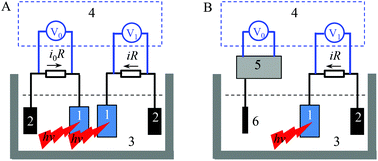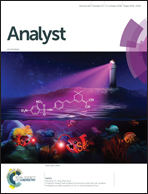A ratiometric photoelectrochemical immunosensor based on g-C3N4@TiO2 NTs amplified by signal antibodies–Co3O4 nanoparticle conjugates†
Abstract
Herein, we report a ratiometric photoelectrochemical (PEC) immunosensor coupled with secondary antibodies–Co3O4 nanoparticle conjugates (Ab2–Co3O4 NPs) for signal amplification. The Ab1-g-C3N4@TiO2 NTs and BSA-g-C3N4@TiO2 NTs act as the sensing and reference photoelectrodes, where Ab1, BSA and TiO2 NTs are the capture antibodies, bovine serum albumin and TiO2 nanotube arrays, respectively. In the presence of target Ag, the sensing PEC photocurrent decreases due to the steric hindrance of Ab1 molecules, which increases the inner resistance of the photoelectrode. The signal-off response is enhanced further using Ab2–Co3O4 NP conjugates due to their steric hindrance effect and the consumption of electron donors by the Co3O4 NPs. Furthermore, the performance of the ratiometric PEC platform is tested using alpha-fetoprotein (AFP) as a model antigen. Under the optimal conditions, the concentration of AFP is detected in the range of 0.4 pg mL−1 to 40 ng mL−1 with a detection limit of 0.2 pg mL−1. This ratiometric strategy is beneficial to improve the reliability and anti-interference ability of PEC immunosensors.



 Please wait while we load your content...
Please wait while we load your content...